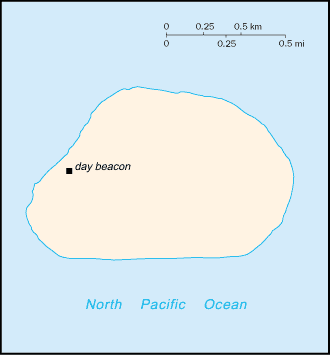
|
Baker Island
Background:
The US took possession of the island in 1857, and its guano deposits were mined
by US and British companies during the second half of the 19th century. In
1935, a short-lived attempt at colonization was begun on this island - as well
as on nearby Howland Island - but was disrupted by World War II and thereafter
abandoned. Presently the island is a National Wildlife Refuge run by the US
Department of the Interior; a day beacon is situated near the middle of the
west coast.
Location:
Oceania, atoll in the North Pacific Ocean, about half way between
Hawaii and Australia.
Area: total: 1.4 sq km.
Area - comparative: About 2.5 times the size of The Mall in Washington, DC.
Coastline: 4.8 km.
Maritime claims: Exclusive economic zone: 200 NM, territorial sea: 12 NM.
Climate and Terrain:
Climate: Equatorial; scant rainfall, constant wind, burning sun.
Terrain: Low, nearly level coral island surrounded by a narrow fringing reef.
Elevation extremes: Lowest point: Pacific Ocean 0 m, highest point: unnamed
location 8 m.
Natural resources: Guano (deposits worked until 1891), terrestrial and aquatic
wildlife.
Land use: Arable land: 0%.
Natural hazards: The narrow fringing reef surrounding the island can be a
maritime hazard.
Environment - current issues: No natural fresh water resources.
Geography - note: Treeless, sparse, and scattered vegetation consisting of
grasses, prostrate vines, and low growing shrubs; primarily a nesting,
roosting, and foraging habitat for seabirds, shorebirds, and marine wildlife.
|
|
People:
Population: Uninhabited. Note: American civilians evacuated in 1942 after
Japanese air and naval attacks during World War II; occupied by US military
during World War II, but abandoned after the war; public entry is by
special-use permit from US Fish and Wildlife Service only and generally
restricted to scientists and educators; a cemetery and remnants of structures
from early settlement are located near the middle of the west coast; visited
annually by US Fish and Wildlife Service.
Government:
Unincorporated territory of the US; administered from
Washington, DC, by the Fish and Wildlife Service of the US Department of the
Interior as part of the National Wildlife Refuge system.
Economy overview:
No economic activity.
Statistics:
Ports and harbors: None; offshore anchorage only; note - there is one small
boat landing area along the middle of the west coast.
Airports: 1 abandoned World War II runway of 1,665 m, completely covered with
vegetation and unusable.
There is a day beacon near the middle of the west coast.
Return to US Minor Outlying Islands
|
